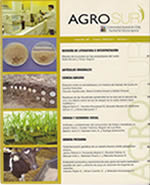Does nitrogen mineralization change in organic fertilizers compost, bokashi and biol from the same poultry guano?
Main Article Content
Abstract
The origin of the materials that make up the organic fertilizers and the process of their elaboration, determine the final nutritional characteristics of the product. The objective of this study was to evaluate the nutritional composition of three organic fertilizers from the same source of material. Compost, bokashi and biol, were produce under controlled conditions of humidity and temperature from poultry guano as source material. The organic fertilizers were incubated at 28 ± 1 °C for 18 weeks, to quantify the potentially mineralizable nitrogen (N). The initial nutritional characterization of fertilizers showed that poultry and biol presented the highest percentages of macronutrients (p> 0.05). The highest mineralization rate was found in poultry (5.19% organic N week-1), similar to compost, 5.17% organic N week-1, and both higher than bokashi (4.47% N organic week-1). The biol was adjusted to a sigmoidal equation, with a mineralization rate of 1.6% organic N week-1, after 50% of the original N content has been mineralized. The accumulated mineralized N varied from 11620 mg kg-1 to 2138 mg kg-1 in the four fertilizers, showing that the main component of accumulated mineralized N is in the form of ammonium and of the four fertilizers, biol was the one that presents the highest proportion of mineralized N as nitrate.

